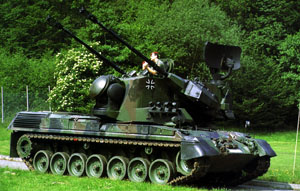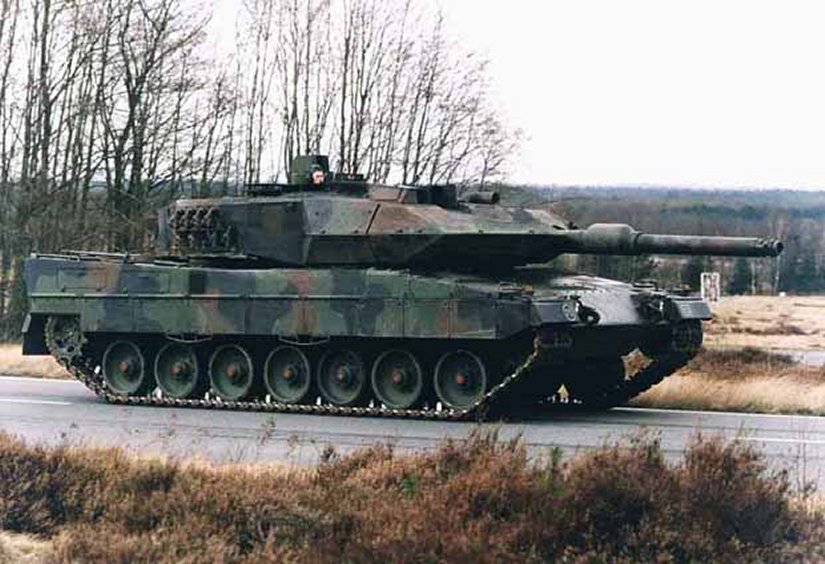Post by Steiner on Dec 19, 2003 11:19:06 GMT -5

The next generation of armour
Profiles in the latest products from Krauss-Maffei Wegmann, the German armoured vehicle experts.
Media coverage of German Leopard 2 tanks spearheading the NATO move into Kosovo on 12 June 1999 confirmed the importance of land systems in future allied out-of-area operations. In the first German combat mission since World War II, the Bundeswehr's 12th Panzer Brigade employed the full range of armoured vehicles in the country's inventory. During the NATO air campaign, German forces stationed in Macedonia also deployed Gepard anti-aircraft systems to provide protection from possible hostile air attack.
Krauss-Maffei Wegmann is a key supplier of armoured vehicles, air defence and artillery systems to the German military.
The recent merger of the two veteran German defence companies, Krauss-Maffei and Wegmann, has created a one-stop shop for customers looking to acquire a total armoured fighting vehicle solution.

Leopard 2
The Leopard 2 is in service with six European armies and efforts continue to enhance the main battle tanks effectiveness to ensure it can play a part on the modern battlefield until well into the next century.
Germany, the Netherlands and Sweden all have in-service versions of the Leopard 2A5, the most modern member of the Leopard family. The improvements include new Mannheim frontal turret armour and other add-on armour packages. Electric gun and turret drive are added, along with an improved night fighting system. This includes a so-called 'hunter killer' sighting system for the commander to identify targets independently of the gunners thermal sight and then hand them over to be engaged. A new navigation system, using both GPS and inertial navigation, is installed and there is the option to install a command and information system to connect the tank to the digital battlefield. The Swedish version, the Strv 122, features additional turret and hull roof armour and a computerised command and information system. The Swedes also are actively considering fitting a defensive aid suite to their tanks, along with engine emission signature management, laser detection, crew laser protection and an obscurant or smoke dispenser. Spain is still negotiating to buy a version of the A5 tank and the German Ministry of Defence is considering a further upgrade package to bring its tanks up to new A6 standard. This includes the installation of the L-55 120mm smooth bore barrel, new armour, a new engine, new sensors and possibly a defensive aids suite. The funding of this upgrade will depend on the outcome of the on-going German strategic defence review. The company, however, is convinced that the improved Leopard 2 is the 'battle tank for 2000'.

Gepard SPAAG
The need to protect tactical forces from hostile air threats was demonstrated graphically during the Kosovo crisis when allied troops in Macedonia regularly went on alert against possible Yugoslav air attack and surprise raids by helicopter-borne special forces. In the end allied air superiority won but at the start of the campaign NATO forces actively deployed low-level air defence systems around their bases. In the forefront of this effort was the German Gepard.
The Gepard is a tracked and armoured mobile low-level air defence system, designed to protect tactical formations. Krauss-Maffei was awarded the prime contract in 1973 to field the first Gepard that was based on the successful Leopard 1 chassis. Up to 1981 Germany, Netherlands and Belgium received a total of 570 vehicles, with the Dutch vehicles being designated CA 1s.
Both Germany and the Netherlands have since embarked on an upgrade programme for the Gepard, that is designated FlakPz1A2 in the Germany army and PRTL-35 GWI by the Dutch army. The later version has a different radar system configuration.
The basic Gepard features a 360 degree rotating turret, with two 35mm cannons. Independent search and tracking radars also are mounted on the turret to make the system fully self-contained and all weather capable.
As part of the upgrade a new digitised fire control unit is installed, along with new command, control and communication systems to integrate the weapon system into the Bundeswehr's air defence command system. Better man-machine interfaces are incorporated in all systems in a bid to improve the system's reaction time to allow a wider profile of targets to be successfully engaged. Countering helicopters, manoeuvring air targets and moving ground targets were all top priorities in the upgrade, along with better hit-and-kill probability.
The new Frangible armour piercing discarding sabot (FAPDS) rounds with a very high muzzle velocity increases the range of ammunition available. A new muzzle velocity measuring system also is fitted as part of the increased lethality package.
To increase the vehicle's self-protection capability new infra-red smoke ammunition is provided to reduce reaction times and performance time of counter-measures. Effectiveness of obscurants is increased to seduce, distract and confuse IR based sensors and guided weapons.
Improvements to the ergonomics of the vehicle, air conditioning of vital components and the crew compartment has been introduced. The system's lifetime has been extended by the replacement of sensitive components.
Key elements
A key element of the upgrade package is the development of a new training system. This includes a new tactical/operator simulator based on the vehicle's turret compartment. A full package of training equipment, training aids, test equipment and documentation has been introduced to reduce training time and costs.
The company describe the upgrade package as resulting in a 'striking combat effectiveness improvement'. This will allow the Gepard to keep pace with the increasing potential of attacking enemy aircraft, helicopters and unmanned aerial vehicles in severe weather conditions and sophisticated electronic warfare environments.

Air defense cannon tank Gepard
Flugabwehrkanonenpanzer Gepard
* Engine performance: 610 KW (830 HP)
* Weight: approx. 47 t
* Maximum speed: approx. 60 km/h
* Operating range: 420 km
* Crew: 3
* Armament:
* Twin mounted automatic cannon 35 mm
* Rate of fire 550 shot for each tubing/min.
* Combat distance: 3,500 m

LEOPARD 2 MAIN ARMAMENT
A new smoothbore gun, the 120 millimetre L55 Gun, has been developed by Rheinmetall GmbH of Ratingen, Germany to replace the shorter 120mm L44 smoothbore tankgun on the Leopard 2. The extension of the barrel length from calibre length 44 to calibre length 55 results in a greater portion of the available energy in the barrel being converted into projectile velocity increasing the range and armour penetration. The L55 smoothbore gun, equipped with a thermal sleeve, a fume extractor and a muzzle reference system, is compatible with current 120mm ammunition and new high penetration ammunition. An improved kinetic energy ammunition known as LKE 2 DM53 was developed as a result of a Tactical Requirement issued in November 1987, and uses the longer gun barrel. With the DM53 round the L55 gun can fire to a range of 5,000m. The effect of the kinetic energy projectile on an enemy target is achieved by 1) the penetrator length and projectile mass and the impact velocity and 2) the interaction between the projectile and the target. The penetrator material is heavy tungsten powder in a monoblock structure. The improved kinetic energy ammunition has higher muzzle energy and recoil forces.



